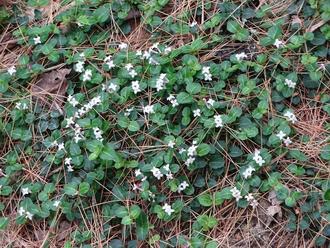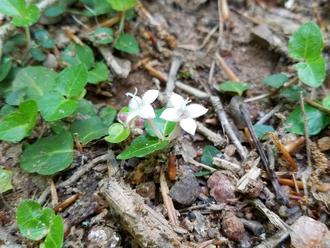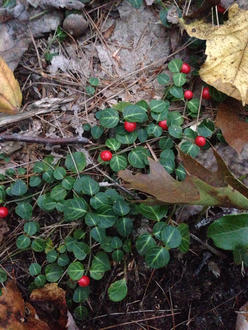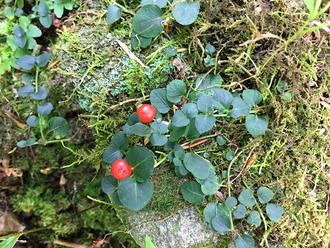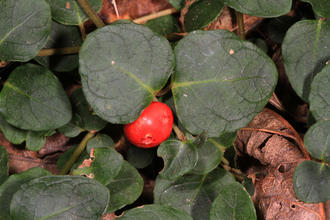Partridgeberry (Mitchella repens L.)
Also known as partridge berry.
↑Summary
A small, mat-forming evergreen vine with red fruit, found in mature forests.
↑Range - Expand
| Legend | Color |
| Native | |
| Native or Not Present |
This tentative map is based on our own research. It may have limited data on Canada and/or Mexico, and there is some subjectivity in our assignment of plants as introduced vs. expanded. Read more in this blog post.
Although this plant occurs somewhere in each of these regions, it may only occur in a small part of some or all of them.
↑Habitat
Found in mature forests in mid-to-late successional stages, on sites protected from fire. Found on a variety of sites, but usually slightly acidic, well-drained, mesic sites. It is particularly common on sites where other vegetation is limited by some combination of shade and poor nutrient availability, including areas under the dense shade of a closed canopy, leached streambanks, shaded sandstone ledges, and bogs.
↑Life Cycle
Partridgeberry is an evergreen perennial that is long-lived relative to its small size. Reproduction is primarily vegetative, with reproduction by seed only happening occasionally. The reproductive strategies and and methods of establishment of this species are not well-documented, but it seems only able to establish in mid-to-late successional stages of forests, in conditions that are relatively stable for long periods of time.
Growth is slow. Flowers and seeds are produced only in small quantities, once plants are well-established. Seeds germinate after a period of cold dormancy; some seeds germinate in the first growing season but many stay dormant until the second season or possibly later. It is not known how long this species persists in the seed bank.
↑Faunal Associations
The fruit is eaten by various birds, including ruffed grouse, northern bobwhite, sharp-tailed grouse, prairie chicken, wild turkey, and previously, the now-extinct passenger pigeon, as well as by mammals, including raccoon, red fox, eastern skunk, eastern chipmunk, white-footed mouse, and woodland deer mouse. The foliage is also eaten by deer.
The flowers are pollinated by bumblebees. Little is known about whether any insects eat the foliage of this plant.
↑Uses
Occasionally used as a landscaping plant, where it is valued for its attractive foliage, its long-persisting red fruit, and its small size. Its use is limited by its slow growth and tendency to be out-competed by taller vegetation in the sunny, nutrient-rich environments of most gardens.
The fruits are edible, but bland. They are made into jam in Newfoundland, and are even sold commercially. They are occasionally recommended as an emergency food due to their high starch content and persistence through much of the winter.
↑Related Plants
This species is the only member of its genus, and also the broader Mitchelleae tribe, in North America. However, the broader Rubioideae subfamily of the Rubiaceae (coffee, madder, or bedstraw) family contains numerous plants, both native and introduced, including genera Galium, Houstonia, Diodia, and Stenaria, among others.
↑Links & External Resources
• Partridgeberry | Fire Effects Information System (FEIS) (About This Site)
• Mitchella repens (Partridge Berry) | Illinois Wildflowers (About This Site)
• Mitchella repens (Partridgeberry) | USDA PLANTS Database (About This Site)
• Mitchella repens | Go Botany (About This Site)
• Mitchella repens (Partridge Berry) | Missouri Botanical Garden Plant Finder (About This Site)
• Partridgeberry | Virginia Tech Dendrology Factsheets (About This Site)
• Mitchella repens | Biota of North America Project (BONAP) (About This Site)
• Mitchella repens | NatureServe Explorer (About This Site)
• Mitchella repens | Missouri Plants (About This Site)
• Partridgeberry | Maryland Biodiversity Project (About This Site)
• Mitchella repens (Partridgeberry) | Minnesota Wildflowers (About This Site)
• Mitchella repens L. (Partridge-berry) | Digital Atlas of the Virginia Flora (About This Site)




